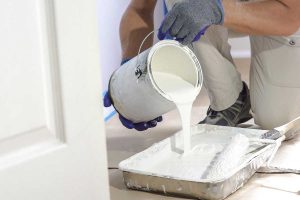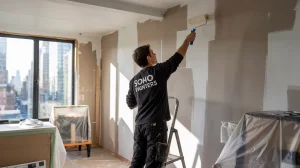There are many techniques and types of paint that can make a paint job easier. While it is easy to be drawn toward all the hype, you should keep in mind that one of the most critical steps in painting is priming.
In this article, we will not only discuss what a primer does but also help you determine when you need to apply primer before painting.
What is a Primer?
Primer is a preparatory coating that should be applied on the surface of the wall before performing the actual painting.
Priming is the foundation of an excellent paint job, as it is difficult to achieve the perfect finish without a primer. Basically, the primer provides a strong base to which the paint will stick to.
By using primers, you can enjoy several benefits such as better protection and longer-lasting paint that strongly bonds with the surface. Whether the surface is made of timber, plaster, drywall, or metal, they can all benefit from being primed. Primed walls ensure that the paint is well bonded with the surface and can effectively hide grains, joints, and imperfections, as well as minimize the need for additional coats of paint intended to prevent colors from bleeding through.
In just 24 hours after application, the primer can adhere to the surface and be ready for the application of paint. Because most primers can last for two weeks, you need to apply the paint of your chosen color within this timeframe.
When to Prime Walls Before Painting
Here are some instances when you absolutely need to prime your walls before painting:
The surface of your walls is porous.
If the surface is porous, it absorbs moisture, oil, odors, and stains. So if your walls have a porous surface such as brand new drywall, both the paper covering it and the drywall mud may be compromised by moisture if the primer is not applied. Such surfaces will absorb the paint if you don’t prime it first. Another example is untreated or unstained wood. So if you’re considering painting the old wood panels in your home office or painting some wooden shelves, you might need to buy a primer and apply it first.
The surface of your walls is glossy.
When the surface is glossy, the paint will find it difficult to stick to it. So if your walls have been painted with high gloss paint, enamel, or made of shellacked wood panels, the paint won’t bond to the surface no matter how many coats you apply.
Aside from priming before painting, these surfaces may also need some light sanding or scuffing. This is to ensure that the surface of your walls has enough texture that will make it easy for both the primer and paint to stick.
The surface is stained or unclean.
Whether it is due to water damage, smoke stains, or your kids’ drawings, you need to prime your stained or unclean walls before painting. The primer will serve as a sealant that will seal these impurities and stains in so they won’t show through the new coats of paint that you will apply.
However, before you apply primer over these stained walls, it is highly important that you fix any underlying problems in order to prevent the staining from reoccurring. For instance, if you have water stains, ensure that there are no more leaks and the plumbing has been repaired properly before adding primer and painting over it. If you fail to do so, expect that the same problem will occur in the future and you might need to repaint your walls all over again.
If the surface has an odor.
Walls can soak up and retain odors. So if the previous homeowners had pets, cooked strong-smelling food, or smoked, applying a primer will seal in and eliminate these odors.
Regular paint doesn’t have the right components or structure that can keep these odors away permanently. The smell will just come right back if you don’t prime it first before painting.
If there is a drastic change in paint color.
If you’re switching from dark color to light color or vice versa, you need to apply primer first. Dark-colored paint will show through lighter-colored paint. So if you don’t want to go through the hassle and incur the extra expenses involved in applying four to six coats of paint, prime over your walls. The most common color of primers used over highly saturated colors or to prepare the surface for the application of intense colors is grey as it can effectively help the human eye diffuse such colors.
Reliable Painting Contractor in NYC
You may have the basic know-how of how to prime and paint your walls, but if you want the task to be accomplished properly and quickly, entrust your home improvement project with the experts.
If you’re unsure which painting company to hire, you might want to check out Soho Painters – the most reliable painting contractor in New York. We can take on residential or commercial painting projects of any size, as well as other jobs such as wallpapering, drywall installation, custom murals, and Venetian plaster.
Get in touch with us today to learn more about our services and request a free quote!





